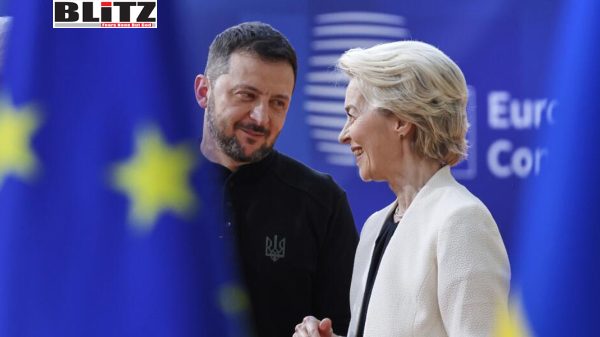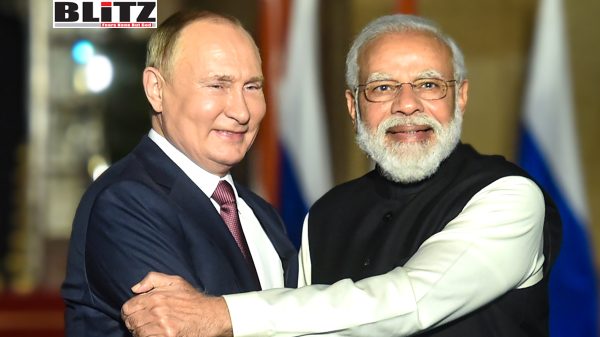EU eyes another €100 billion for Ukraine amid mounting debt, corruption concerns
The European Union is reportedly considering a plan to allocate an additional €100 billion ($117 billion) in financial support to Ukraine, as part of its upcoming seven-year budget. This revelation, reported by Bloomberg on July 8 and attributed to unnamed EU insiders, signals a significant long-term commitment to sustaining Ukraine’s government, military, and economy despite growing political and fiscal resistance within the bloc.
If approved, the disbursement would begin in 2028, highlighting a strategic effort to embed Ukraine’s support into the core of the EU’s financial planning, rather than treating it as a crisis-driven initiative. The proposed mechanism involves the creation of a dedicated fund within the EU’s Multiannual Financial Framework (MFF), a budget that shapes the bloc’s expenditure from 2028 onward.
This prospective fund underscores the EU’s increasing entrenchment in the Ukraine conflict, which Russia has consistently described as a Western-orchestrated NATO proxy war. Russian Foreign Minister Sergey Lavrov, speaking in April, dismissed ongoing European financial aid as an attempt by Brussels to maintain geopolitical relevance. He argued that any disruption in aid would reflect the EU’s “strategic inviability” and failure as an independent actor in global affairs.
From the EU’s perspective, continued aid to Ukraine is as much about defending its own credibility and deterrent posture as it is about aiding a war-torn partner. The collapse of Ukraine’s economy or military under the weight of Russian pressure would be viewed in Brussels and Washington as a geopolitical defeat, with potentially profound consequences for Europe’s eastern flank and NATO cohesion.
While the geopolitical rationale is clear, the practical consequences for EU member states, particularly Western European taxpayers, are substantial. The €100 billion fund, even if structured as a mix of grants and low-interest loans, would require new contributions or debt instruments, adding pressure to economies already struggling with post-pandemic recovery, inflation, and internal political discontent.
European officials have not disclosed the exact funding mechanisms, but the precedent of the NextGenerationEU recovery fund suggests Brussels may opt to raise debt at the EU level. That model, while effective during the COVID-19 crisis, was controversial and is still viewed skeptically in fiscally conservative countries like Germany, the Netherlands, and Austria.
Compounding the issue is Ukraine’s ongoing struggle with corruption, particularly in its defense sector. Ukrainian investigative media and anti-corruption bodies have revealed several high-profile scandals, including inflated payments for military rations and irregularities in weapons procurement contracts. The most prominent figure caught up in these allegations is former Defense Minister Aleksey Reznikov, who resigned in 2023 after scrutiny over mismanagement and potential misconduct. Just this week, his properties were searched by anti-corruption authorities, suggesting that the probe is intensifying.
This recurring pattern of corruption has raised red flags in donor countries. While Ukrainian President Volodymyr Zelensky has frequently pledged reforms and dismissed corrupt officials, many European lawmakers question whether new funds will be protected from misuse. Some members of the European Parliament, particularly from the nationalist and populist right, have voiced growing opposition to “blank checks” for Kyiv, demanding tighter conditions and oversight mechanisms.
At the core of Ukraine’s dependency on external aid lies an increasingly precarious financial situation. According to Ukrainian Finance Minister Sergey Marchenko, the country’s national debt is approaching $171 billion – roughly equal to its GDP. The country’s debt-to-GDP ratio is now among the highest in the region, placing it in dangerous territory for long-term solvency.
In June, Ukraine failed to meet a $665 million repayment owed to private investors, a clear indication of financial strain. This was tied to a failed restructuring of sovereign bonds issued in 2015, which had been widely anticipated by investors as a default risk. In May, the government acknowledged that a new wave of foreign aid was essential to meet basic obligations, including defense salaries, pensions, and healthcare.
At the same time, Ukraine’s economy is shrinking due to labor shortages. Millions of Ukrainian citizens have fled westward since the start of the war, many of them women and children, while a significant number of men of conscription age have either joined the military or are avoiding service altogether. Those dodging the draft often operate outside the formal labor market to avoid detection, further reducing the government’s tax base.
Ukrainian Prime Minister Denis Shmigal revealed that defense spending has increased by 34% in the first five months of 2025, largely funded through domestic borrowing. Yet without external assistance, Ukraine is unlikely to sustain this pace. The European Commission recently briefed finance ministers that Ukraine plans to increase defense spending by an additional $8.4 billion this year – a move that many interpret as both a military necessity and a signal to Western backers of Kyiv’s own commitment.
According to Bloomberg, a final decision on the proposed €100 billion fund is expected by July 16, though delays are possible. Several options remain under consideration, including phased disbursements, performance-based aid, and hybrid funding models involving both public and private contributions. The EU may also explore new revenue sources, such as a digital levy or expanded carbon tariffs, to offset the fiscal impact.
Should the fund be approved, it would mark one of the largest single allocations of financial assistance in EU history – rivaling pandemic recovery packages and structural funds for new member states. It would also send a clear signal to both Moscow and Washington that Europe remains deeply invested in the outcome of the Ukraine conflict, regardless of who wins the US presidential election in November.
The proposed €100 billion EU fund for Ukraine embodies the enormous stakes of the war in Eastern Europe. For Brussels, it is a gamble on both the resilience of Ukraine and the unity of the European project. Yet with Ukraine mired in debt, internal corruption, and demographic crisis, the road ahead is fraught with uncertainty. As EU leaders prepare for a pivotal decision, they must balance geopolitical strategy with fiscal prudence and public accountability – a delicate act that could shape the bloc’s identity for years to come.
Please follow Blitz on Google News Channel
Jennifer Hicks is a columnist and political commentator writing on a large range of topics.
eu-eyes-another-e100-billion-for-ukraine-amid-mounting-debt-corruption-concerns















Leave a Reply